Chinese anti-aircraft artillery in the Sino-Japanese War
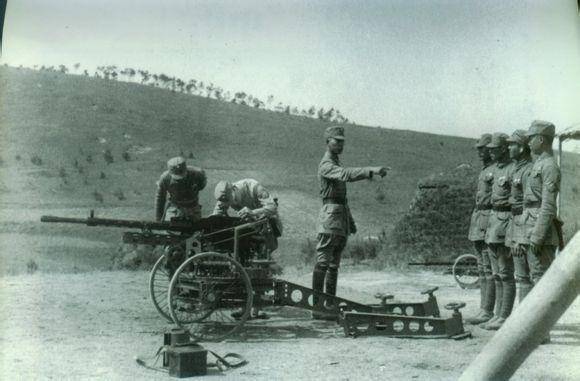
During the Sino-Japanese War, the air defense units of the Chinese army had a number of 20-88-mm anti-aircraft artillery systems of foreign origin, which were used for firing at air and ground targets. After the surrender of Japan, these anti-aircraft guns, as well as captured Japanese guns, were actively used by the troops of the Kuomintang and the CPC in the civil war.
20-mm anti-aircraft guns
In the early 1930s, the Chinese government purchased 120 20-mm anti-aircraft guns from Switzerland. Apparently, these were Oerlikon S assault rifles (in Chinese sources, these installations are referred to as Oerlikon MCS).
According to information published by Chinese authors, 20x110 RB ammunition was used to fire these anti-aircraft guns. The muzzle velocity of the 117 g projectile was 830 m / s. Rate of fire - 450 rds / min. A box magazine with a capacity of 15 shots was used for food. The mass of the gun without the machine is 68 kg. The weight of the unit in transport position with wheel travel is about 450 kg. The effective firing range at air targets did not exceed 1 m.
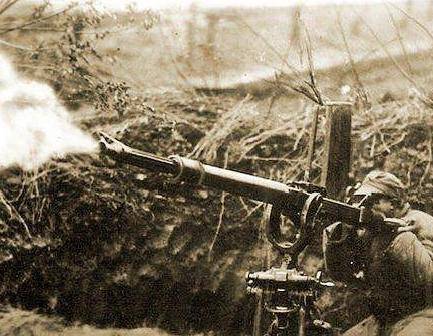
Although the combat rate of fire of the 20-mm "erlikons", due to the low rate of fire and the use of 15 charging box magazines, was relatively small, in general, due to the simple and reliable design and acceptable weight and size characteristics, it was quite effective weapon.
In terms of ballistic characteristics and rate of fire, the 20-mm anti-aircraft guns delivered to China corresponded to the anti-aircraft gun adopted by the Wehrmacht under the designation 2,0 cm Flak 28.
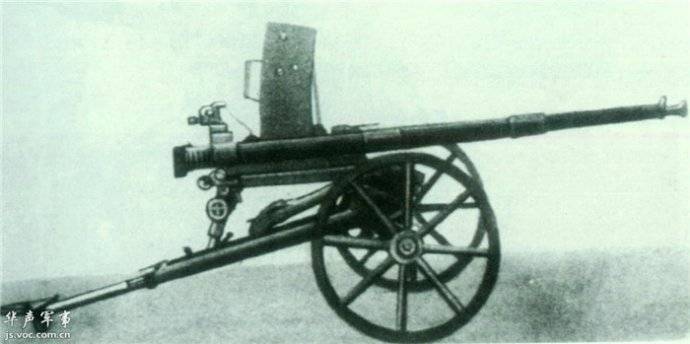
But, judging by its appearance, the modification intended for the Chinese army differed in the design of the machine and the aiming mechanism.
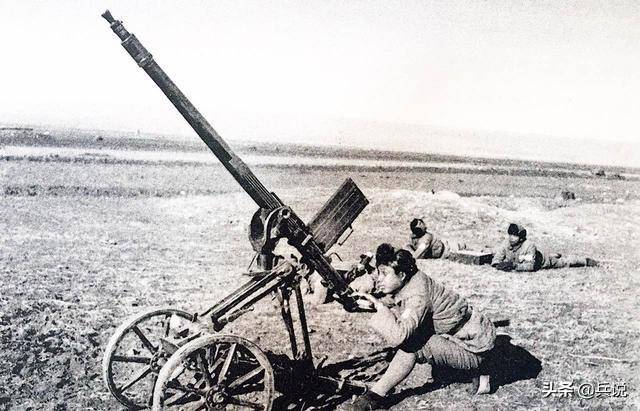
Despite the relative small number, the "erlikons" available in the Chinese army played a significant role in the hostilities against the Japanese. They were used to repel enemy raids. aviation and proved to be very effective in the fight against poorly protected Japanese tanks.
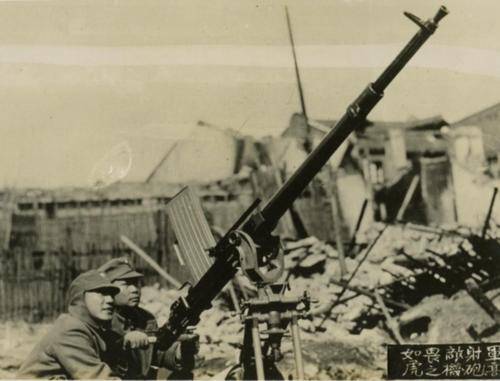
So, according to Chinese data, in March 1938, an anti-aircraft artillery unit armed with 20-mm "eerlikons", which is directly subordinate to the headquarters of the 2nd Army, during the hostilities in the vicinity of Taierzhuang, ambushed an enemy column. At close range, 12 Japanese Type 94 tankettes were knocked out by sudden dagger fire and more than 50 enemy infantrymen were destroyed.
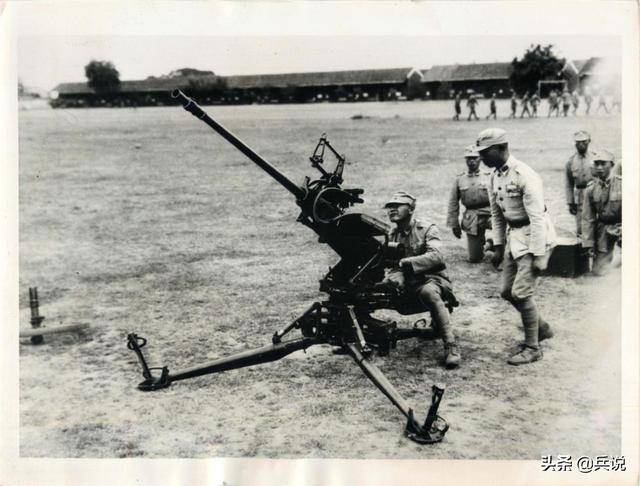
In addition to the early modification of the Oerlikon S, the Chinese army had anti-aircraft installations similar to the German 2,0 cm Flak 28. Apparently, they were purchased after the outbreak of the Sino-Japanese War.
Before the termination of military-technical cooperation with Germany, the Chinese armed forces in 1937 managed to receive 120 Solothurn ST-5 anti-aircraft guns.
Sources differ as to which country these anti-aircraft guns were obtained from. Some Chinese authors argue that these were not Swiss, but German 2,0 cm FlaK 30. In the Military Museum of the Chinese Revolution, this name is indicated in the explanatory plate.
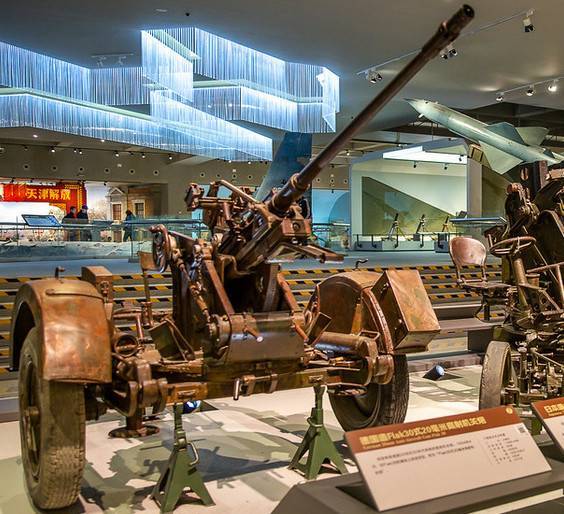
Anti-aircraft gun 2,0 cm FlaK 30 at the Military Museum of the Chinese Revolution
The rapid-firing 20-mm anti-aircraft gun 2,0 cm FlaK 30 had a simple design, the ability to quickly disassemble and assemble, and a relatively low weight. The automatic building sight, with the correct data entry, ensured fairly accurate shooting. The carriage made it possible to fire in a circular manner with a maximum elevation angle of 90 °. The installation had a recoil device and ammunition supply from a magazine for 20 shells.
For firing from the 2,0 cm FlaK 30, ammunition 20 × 138 mm (long "Solothurn") was used, with a higher muzzle energy than the 20 × 110 mm projectiles intended for the 2,0 cm Flak 28 anti-aircraft gun. g left the barrel at a speed of 115 m / s. Also, the ammunition load included armor-piercing incendiary tracer and armor-piercing tracer shells. The latter weighed 900 g and at an initial speed of 140 m / s at a distance of 830 m it could penetrate 300 mm armor.
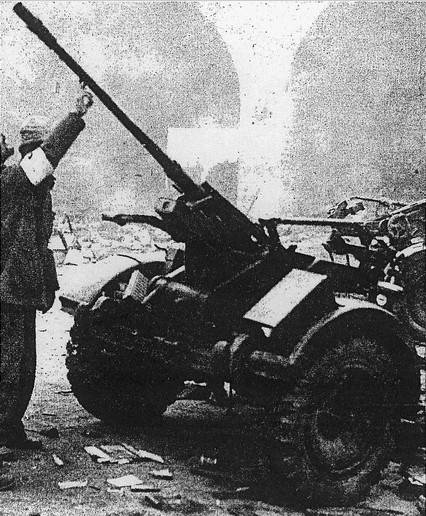
For the first time, the 2,0 cm FlaK 30 was used by Chinese troops in 1937 in the battles of Shanghai and Nanjing. At least one 2,0 cm FlaK 30 anti-aircraft gun was captured by the Japanese in December 1937.
During the hostilities in China, the Japanese Imperial Army had a significant superiority in combat aviation, and the Chinese government was forced to acquire anti-aircraft guns in different countries.
The Danish 20mm M1935 Madsen mount had very good characteristics for its time. With a mass of 278 kg, this versatile system in its characteristics was not inferior to the much heavier Oerlikon S.
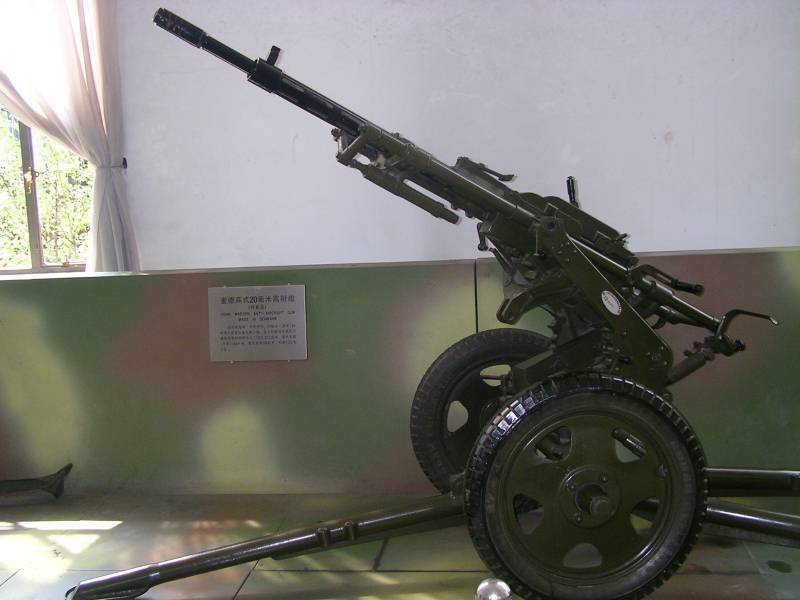
20mm M1935 Madsen universal mount at the Chinese Revolution War Museum
A universal rapid-fire installation chambered for a 20x120 mm caliber, according to the principle of automatic operation, repeated Madsen's infantry machine gun chambered for a rifle cartridge. The Danish 20-mm machine gun had an air-cooled barrel and was equipped with a muzzle brake. Food was carried out from box magazines - for 15 or drum - for 30 shells. The ammunition load included shots with armor-piercing, armor-piercing tracer and fragmentation shells. Rate of fire - 500 rounds / min. Combat rate of fire - up to 120 rds / min. Effective firing range at air targets - up to 1 m.
The M1935 Madsen installation was positioned as a universal one and was intended to combat air targets and enemy armored vehicles. An armor-piercing projectile with a mass of 154 g s had a speed of 730 m / s, and at a distance of 500 m along the normal it could penetrate 20 mm armor.
The first M1935 Madsen installations entered the anti-aircraft units of the 120th Kuomintang Division in 1938. In 1939, an attempt was made to establish licensed assembly of Danish 20-mm installations at Chinese enterprises, for which the necessary parts and components were ordered. But due to the occupation of Denmark by the German army, this order was partially fulfilled, and the Chinese managed to collect only four working samples.
In 1936, the Chinese government purchased several dozen Breda Modèle 20 (Breda M35) 35mm anti-aircraft guns in Italy. This weapon was created in 1935 by Breda Meccanica Bresciana on the basis of the French Hotchkiss Mle 13,2 1930-mm machine gun.
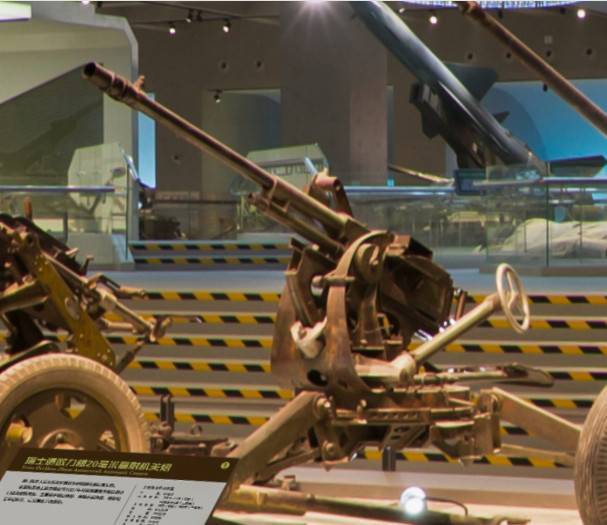
20-mm anti-aircraft gun Breda M35 at the War Museum of the Chinese Revolution
For firing from the Breda M35, 20x138 mm ammunition was used, also used in the German 2,0 cm FlaK 30 assault rifles; 2,0 cm Flak 38 and 2,0 cm Flakvierling 38. In terms of ballistic characteristics and armor penetration, the Italian 20-mm anti-aircraft gun corresponded to these German models.
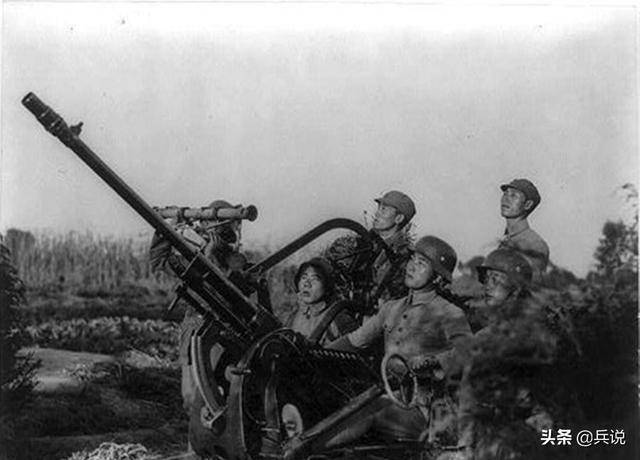
Power, as in the French machine gun, came from a rigid clip-tape for 12 rounds. The clip was fed from the left side, and as the cartridges were consumed, it passed through the receiver and fell out on the right. Rate of fire - 500 rounds / min. Combat rate of fire - up to 150 rds / min. Installation weight - about 340 kg. When separating the wheel drive, it was possible to conduct a circular attack. Calculation - 6 people.
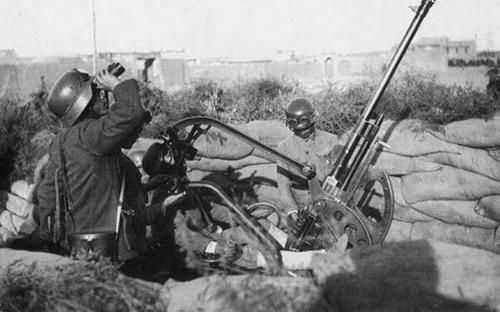
20-mm anti-aircraft gun Breda M35 in position in the vicinity of Shanghai
Italian-made 20-mm installations entered the anti-aircraft units of the 87th, 88th and 36th Kuomintang infantry divisions, which were considered elite. Each infantry regiment of the division was assigned an anti-aircraft battery, in which there were 6 20-mm installations.
With proper training, the calculations of the Breda M35 anti-aircraft guns showed good results. Chinese sources say that in October-November 1937, during the battle of Xinkou, the fire of a 20-mm anti-aircraft battery attached to the 216th Infantry Regiment of the 36th Division, shot down 3 Japanese Type 95 biplane fighters. In some cases, 20- mm Breda M35 mounts were very successfully used against Japanese armored vehicles and infantry.
37-40 mm anti-aircraft guns
Chinese sources claim that in 1937, shortly before the end of cooperation with Germany, 60 37-mm anti-aircraft guns 3,7 cm Flak 18 were delivered to China.
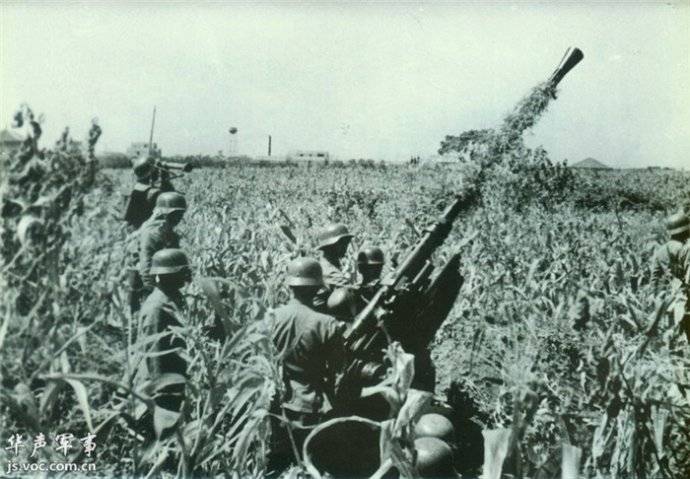
37-mm automatic anti-aircraft gun 3,7 cm Flak 18 in a firing position
The 37-mm rapid-fire anti-aircraft gun was officially adopted by the Wehrmacht in 1935.
The number "18" in the designation is explained by the fact that after the defeat of Germany in the First World War, it was forbidden to have and develop anti-aircraft artillery. The anti-aircraft artillery units re-created in the early 1930s for conspiracy purposes were called "railway battalions" until 1935, and the anti-aircraft artillery systems, designed between 1928 and 1933, had the designation "arr. eighteen". Thus, in case of inquiries from Great Britain and France, the Germans could answer that these were not new weapons, but old ones, designed in 18, even before the end of the First World War.
Automatic 3,7 cm Flak 18 worked at the expense of recoil energy with a short barrel stroke. The shooting was carried out from a pedestal gun carriage, supported by a cruciform base on the ground. In the stowed position, the gun was transported on a four-wheeled cart.
Power was supplied from 6 charging clips on the left side of the receiver. Rate of fire - up to 150 rds / min. The mass of the gun in the firing position is 1 kg, in the stowed position - 760 kg. Calculation - 3 people.
For firing from a 37-mm anti-aircraft gun, a unitary shot with a dimension of 37x263 mm was used. The muzzle velocity, depending on the type and mass of the projectile, was 800–860 m / s. An armor-piercing tracer projectile weighing 680 g with an initial speed of 800 m / s at a distance of 800 m, when hit at an angle of 60 °, pierced 25 mm armor. The ammunition load also included shots: from fragmentation-tracer, fragmentation-incendiary and fragmentation-incendiary-tracer grenades. The maximum firing range at air targets is 4 m.
The anti-aircraft gun 3,7 cm Flak 18, serviced by a qualified crew, in the late 1930s posed a very serious danger to all combat aircraft, without exception, flying at an altitude of 2 m, and it could successfully fight light armored vehicles.
It is reported that the 3,7 cm Flak 18 anti-aircraft guns were used in Nanjing in August 1937. But, unfortunately, it was not possible to find any details of the combat use of 37-mm German-made anti-aircraft guns during the Sino-Japanese War. This may be due to the fact that, due to the termination of military-technical cooperation with Germany, the Chinese were unable to obtain the required number of rounds for 37-mm automatic anti-aircraft guns.
Starting in mid-1944, the troops of Generalissimo Chiang Kai-shek, who fought the Japanese in Burma, began to receive Canadian-made 40-mm Bofors L60 anti-aircraft guns. This automatic anti-aircraft gun entered the history as one of the most advanced and massive means of fighting an air enemy during the Second World War.
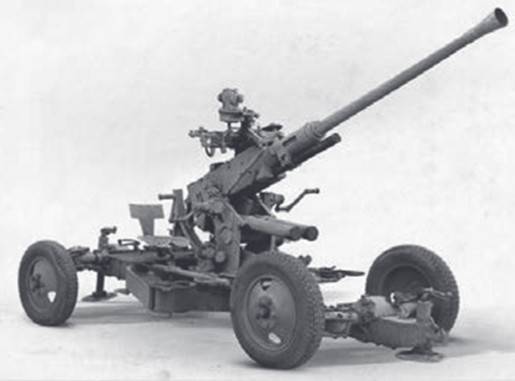
40-mm automatic anti-aircraft gun Bofors L60
The Bofors L60 automatic cannon fired with 900-gram fragmentation shells with an initial speed of about 850 m / s. The impact of one such projectile in most cases was sufficient to destroy a single-engine combat aircraft.
The altitude reach was 4 m. The rate of fire was about 000 rds / min. The anti-aircraft gun was mounted on a four-wheeled towed vehicle. At the firing position, the carriage frame was lowered to the ground for greater stability. In case of urgent need, shooting could be carried out from wheels, without installing supports, but with less accuracy. The mass of the anti-aircraft gun in a combat position is about 120 kg. Calculation - 2 people.
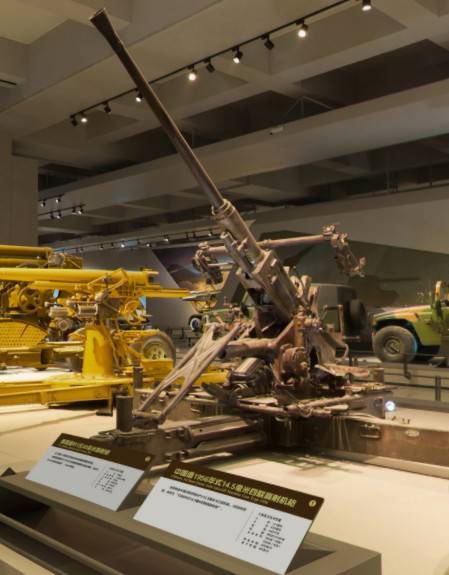
40-mm automatic anti-aircraft gun Bofors L60 at the Military Museum of the Chinese Revolution
According to Chinese data, the Kuomintang received more than 1947 80-mm anti-aircraft guns before 40. It is not known how effectively the Bofors L60 were used by the troops of the Chinese nationalists against the Japanese aviation? After the victory of the CCP in the civil war, several serviceable 40mm anti-aircraft guns became the trophies of the communists. One of these weapons is now on display at the Military Museum of the Chinese Revolution in Beijing.
75-88 mm anti-aircraft guns
In 1934 and 1936, the Chinese government purchased two batches of Bofors 75 mm Model 1929 anti-aircraft guns from Sweden (28 units in total). Along with the 75-mm cannons, 4 Siemens searchlights with a diameter of 150 cm, 6 optical rangefinders and two sound detecting devices were purchased.
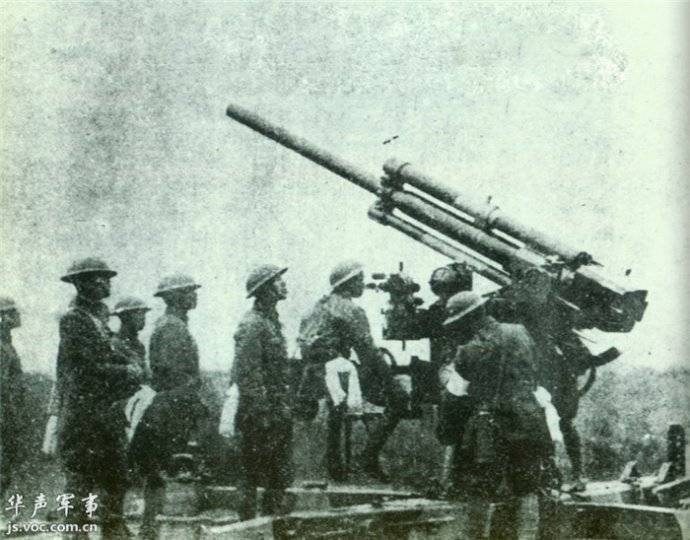
Crew next to a 75-mm M1929 anti-aircraft gun, which is in a firing position at a firing position
For the early 1930s, the 75 mm М1929 gun turned out to be very successful and enjoyed success with foreign buyers.
The gun was mounted on a cruciform carriage, which could be transported using a pair of two-wheeled carts attached to each end.
The mass in the firing position was 3 kg. Traveling - 300 4 kg. A projectile weighing 200 kg left the barrel with an initial speed of 6,4 m / s. Reach in height - 850 m. A well-prepared calculation could provide a rate of fire - up to 9 rds / min.
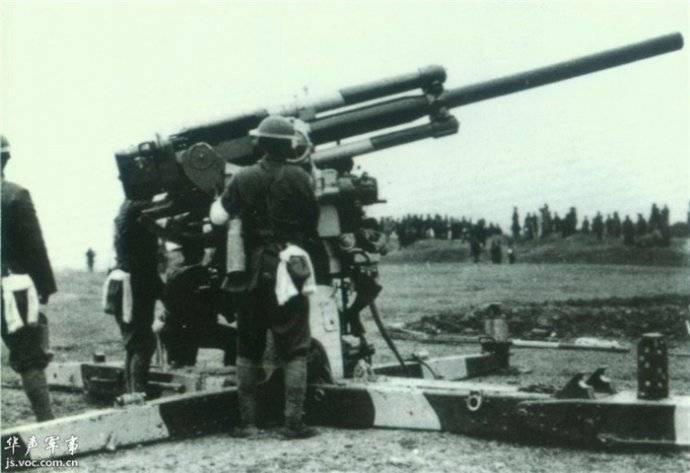
All Chinese 75-mm M1929 anti-aircraft guns were transferred to the 41st anti-aircraft artillery regiment: 4 guns in six batteries. The remaining four 75-mm anti-aircraft guns were used to prepare the calculations.
Despite their relatively small numbers, these guns played a significant role in repelling Japanese bombers' raids.
For the first time, anti-aircraft batteries equipped with M1929 entered the battle on August 15, 1937. According to Chinese data, on this day, 75-mm anti-aircraft guns, together with 20 and 37-mm machine guns, shot down one and damaged several Japanese aircraft. According to Chinese sources, during the defense of Nanjing, Japanese aircraft bombed the city 118 times, while 12 Japanese bombers were shot down by anti-aircraft fire.
During the defense of Nanking, 75-mm anti-aircraft guns fired at ground targets to the last. In this case, four guns were lost. Japanese troops captured one anti-aircraft gun in good condition. On the basis of this captured specimen, Japan created its own 75-mm Type 4 anti-aircraft gun, which was put into service in 1943.
M1929 guns were used to defend Shanghai, Wuhan and Chongqing. According to the same sources, in just the years of the Sino-Japanese War, 75-mm anti-aircraft guns opened fire on air targets more than 7 times, shooting down 000 Japanese aircraft. However, the results announced by the Chinese calculations are most likely grossly overestimated.
At the beginning of 1938, 82 T-26 tanks, 30 spare tank engines, 30 Comintern artillery tractors, 10 ZIS-6 vehicles, 20 76-mm anti-aircraft guns mod. 1931, 40 thousand rounds for them, spare artillery barrels, as well as several PUAZO, searchlights and sound direction finders.
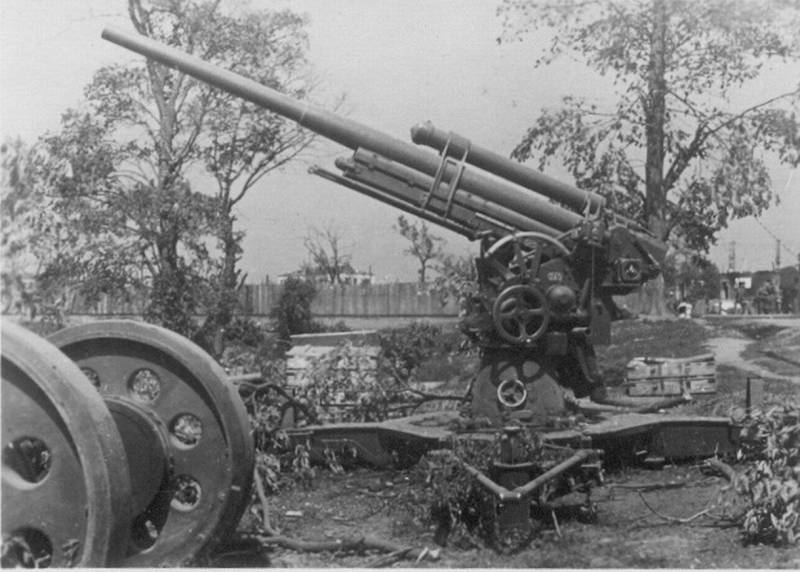
76-mm anti-aircraft gun mod. 1931 (3-C)
Anti-aircraft 76-mm gun mod. 1931, also known as 3-K, appeared thanks to military-technical cooperation between the USSR and Germany.
In the late 1920s, Rheinmetall-Borsig AG created several experimental 75mm anti-aircraft guns. However, these artillery systems were not adopted by the Reichswehr, and the weapon, known as the 7,5 cm Flak L / 59, was offered to the USSR.
The original samples, made in Germany, were tested at the Research Anti-Aircraft Range in February-April 1932. In the same year, the gun, converted to a caliber of 76,2 mm, was adopted by the Red Army under the designation “76-mm anti-aircraft gun mod. 1931 " (3-K).
Anti-aircraft gun "arr. 1931 " was a completely modern model with good ballistic characteristics for that time. Its carriage with four folding beds provided a circular fire. With a projectile weight of 6,5 kg, the height reach was 9 km. Rate of fire - 15 rounds / min. The mass in the firing position is 3 kg, in the stowed position - 750 kg.
Soviet 76-mm 3-K guns were used for air defense of important Chinese administrative and industrial facilities. By mid-1943, these guns were taken out of service. Apparently, this happened due to a shortage of shells and an unsatisfactory technical condition.
In 1937, China ordered 20 8,8 cm SK C / 30 naval guns from Germany. 88-mm universal guns, manufactured by Krupp, together with optical rangefinders and communications equipment, were located at fixed positions in Jiangying, Wuhan, Nanjing and Xiaoshan. The four-gun batteries were intended for anti-aircraft fire and were supposed to counteract the Japanese gunboats.
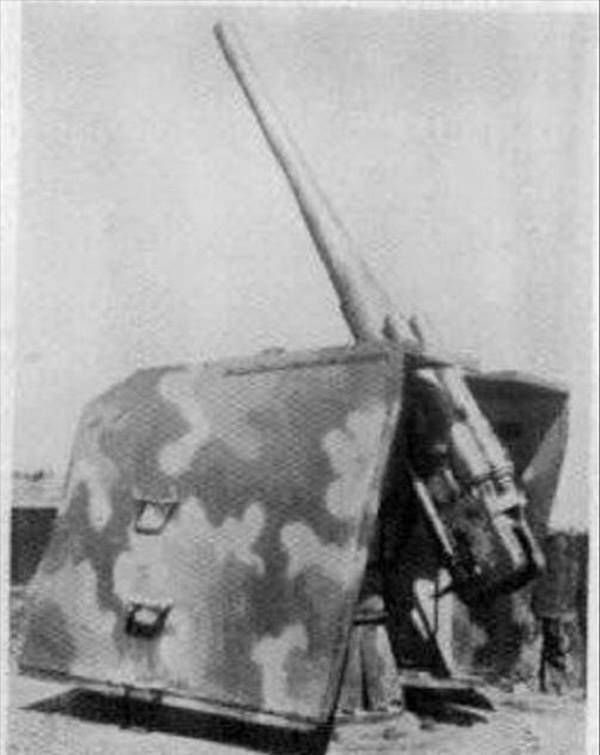
Universal 88 mm gun 8,8 cm SK C / 30 in a firing position
This versatile 88-mm gun, adopted in Germany in 1933, was mainly intended for arming medium-displacement ships. The body weight of the gun without the machine and the armor shield was 1 kg. The total weight of the structure is 230 7 kg. The muzzle velocity of a 400 kg fragmentation projectile is 9 m / s. Reach in height - 800 m. Rate of fire - 9 rds / min.
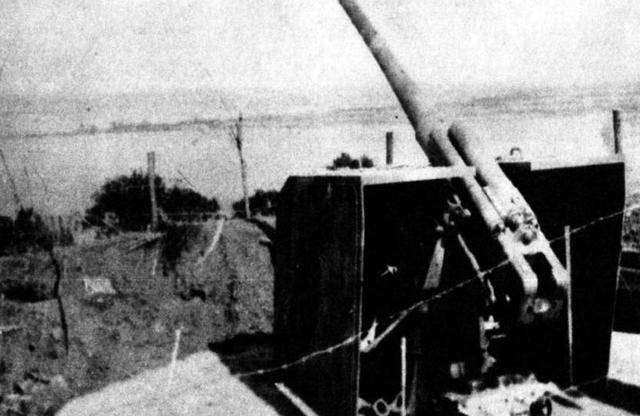
In the initial period of the Sino-Japanese War, the 8,8 cm SK C / 30 guns were actively used in hostilities and mainly fired at ground targets. Due to the stationary placement, the Chinese artillerymen were unable to evacuate them during the offensive of the Japanese army in 1937 and lost 16 guns. Part of the German-made 88-mm cannons was captured at Nanking Fort in good working order, along with ammunition.
Japanese engineers carefully studied captured artillery systems. In 1939, the Imperial Army received the 88-mm Type 99 anti-aircraft gun, which was created on the basis of the German 8,8 cm SK C / 30 cannon and corresponded to it in terms of its main characteristics.
Evaluation of the effectiveness of Chinese anti-aircraft artillery used in the war with Japan
During the war with Japan, the Chinese army had fairly modern anti-aircraft guns, but there were few of them, and they did not have a noticeable effect on the course of hostilities.
First of all, this was due to the fact that the Kuomintang command used anti-aircraft guns separately and did not organize a network of observation posts for the air situation.
In addition, the preparation of the Chinese crews was often very weak, so they sometimes fired defensive fire, corrected it visually, without using rangefinders and anti-aircraft fire control devices.
As a rule, from 1937 to 1945, anti-aircraft artillery in China covered headquarters, large air bases and administrative-industrial centers, and military units in most cases were defenseless from attacks by Japanese bombers.
In addition, the presence of anti-aircraft guns in the troops, released in different countries, the use of various ammunition and spare parts for them, made maintenance and repairs very difficult.
To be continued ...
Information